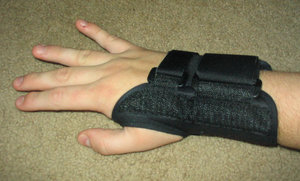Goodyear-Smith F, Arroll B. What can family physicians offer patients with carpal tunnel syndrome other than surgery? A systematic review of nonsurgical management. Ann Faro Med 2004; 2:267-273.
* CLINICAL QUESTION
Are nonsurgical approaches to carpal tunnel syndrome effective?
* BOTTOM LINE
In this systematic review, nonsurgical treatments of carpal tunnel syndrome using injected or oral steroids provided temporary relief. Spontaneous resolution is more common than you may think: nearly 50% of patients receiving placebos improved.
Long-term data on most treatments are lacking. In the few studies with long-term follow up, as many as 50% of patients had surgery during the first year after enrollment. (LOE=1a-)
* STUDY DESIGN
Systematic review
* SETTING
Various (meta-analysis)
* SYNOPSIS
These authors systematically reviewed English-language randomized controlled trials of nonsurgical treatments of carpal tunnel syndrome. They did an exhaustive search of the literature, including Medline, EMBASE, the Cochrane Library, and the registry of controlled trials. They also hand-searched references from previously retrieved articles, and communicated with authors to obtain unpublished material.
Each author assessed the quality of the studies using the PEDro (Physiotherapy Evidence Database) scale, which gives a total score out of 10 possible points. Any disagreements were resolved by consensus. Studies had to have a score of at least 3 for inclusion.
The authors ended up with 2 systematic reviews, 16 randomized controlled trials, and 1 quasi-experimental study that met their requirements. They found a fairly high rate of spontaneous resolution--nearly 50% of patients treated with placebo improved. Local steroid injection significantly improved symptoms, but 50% of the patients had surgery within 1 year. Oral steroids provide short-term improvement, but there are no long-term data.
The following treatment modalities had limited data on their effectiveness (small studies, poor design, mixed or conflicting results): laser-acupuncture, exercises, ultrasound, splinting, and yoga. The authors were unable to find support for the use of nonsteroidal anti-inflammatory drugs, chiropractic manipulation, pyridoxine, diuretics, or magnets.
COPYRIGHT 2004 Dowden Health Media, Inc.
COPYRIGHT 2004 Gale Group



